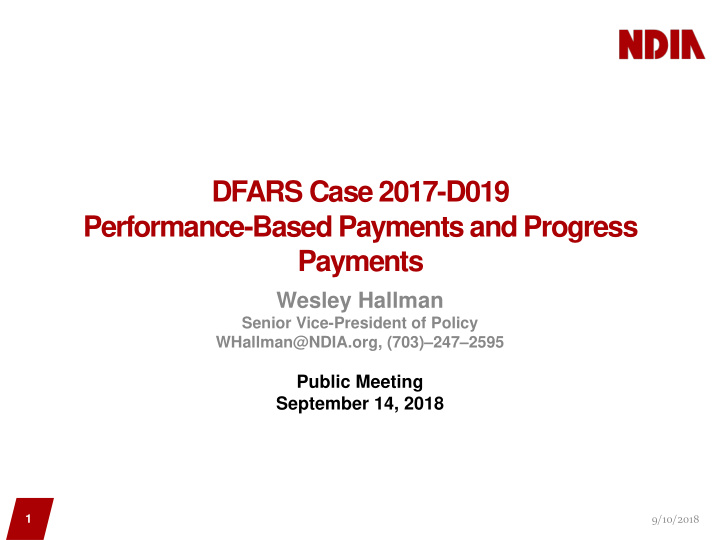



DFARS Case 2017-D019 Performance-Based Payments and Progress Payments Wesley Hallman Senior Vice-President of Policy WHallman@NDIA.org, (703)–247–2595 Public Meeting September 14, 2018 1 9/10/2018
DFARS Case 2017-D019 INDUSTRY CONCERNS 2 9/10/2018
Overview & Recommendation • This Rule… – Discourages industry investment in innovation – Is duplicative and unnecessarily increases bureaucracy and oversight – Disrupts cashflow and drives prices higher – Distorts competition – Punishes contractors who accept high risk and challenging performance requirements – Contradicts congressional intent • We Recommend… – That DoD rescind this proposed rule in its current form – Or extend the comment period and provide another public meeting with industry to discuss further 3 9/10/2018
Decreases Investment in Innovation • Increasing working capital requirements for production and slowing the recovery of capital via contract financing payments will reduce the capital available for: – Innovation (Company-funded R&D + IRAD) – Affordability (Capital improvements) • This contradicts DoD’s emphasis on innovation and capability 4 9/10/2018
Increased Bureaucracy & Oversight • Currently, DoD has the ability to establish performance requirements, metrics and incentives for each contractor • Implementation of this rule at the enterprise level will complicate reporting and planning for both the contractor and government • This rule would create a duplicative requirement and would add another layer of bureaucracy in an already cumbersome process 5 9/10/2018
Disrupts Cashflow and Increases Prices • Cash flow disruptions at the Prime level will flow down to all tiers of the supply chain – Reducing lower-tier companies’ desire to do business with DoD – Negatively impacting contractors’ ability to meet basic payment requirements including payroll • Prices will increase as industry seeks greater margins to offset loss of government provided financing – Weighted Guidelines (WGL) calculations specifically allow for greater margins where industry has assumed greater financing risks 6 9/10/2018
Distorts Competition • This rule allows the government to pick “winners and losers” by subjective application of the payment rate criteria • Contractors preserving (or enhancing) contract financing payment rates will have a competitive advantage built in during the bidding process – These companies/BUs can then bid lower prices and win more business • Historically, the government has avoided allowing access to contract financing to become competitive advantage – This is why interest on commercial financing is an unallowable cost 7 9/10/2018
Punishes Contractors • Contractors that accept high risk and challenging performance requirements are unfairly punished • Performance on all contracts will be punished – even the highest performing – due to the challenges and risks in others 8 9/10/2018
Contradicts Congressional Intent • Section 831 of the FY17 NDAA sought to align DoD practices on performance-based payments with the FAR and remove barriers for their increased use – (e.g. unique accounting systems/ties to cost incurred) • Section 831 did NOT address progress payments based on cost • This proposed rule would: – Erect new barriers for the use of PBPs and progress payments – Bring DoD further out of alignment with FAR based practices – Irrationally discriminate based on end item • (Selectively applying the rule to progress payments to aircraft, satellites, vehicles, but not shipbuilding or Navy MRO work, etc.) 9 9/10/2018
Recommendations • DoD should rescind this proposed rule • If not, extend the comment period and provide another opportunity for industry to publicly comment 10 9/10/2018
Thank You Direct questions to: Wesley Hallman, Whallman@NDIA.org 11 9/10/2018
Recommend
More recommend